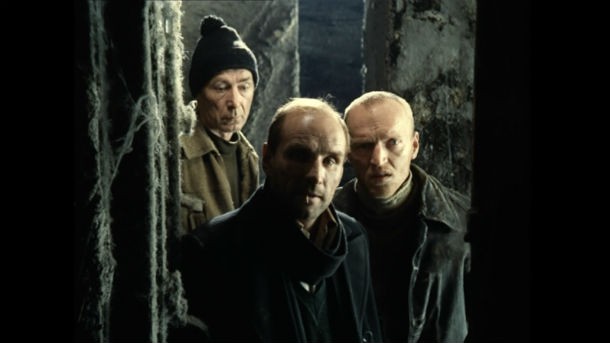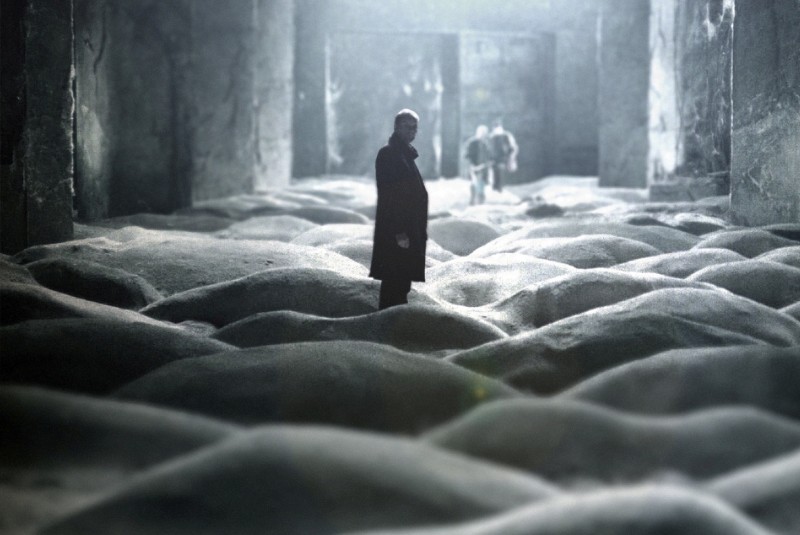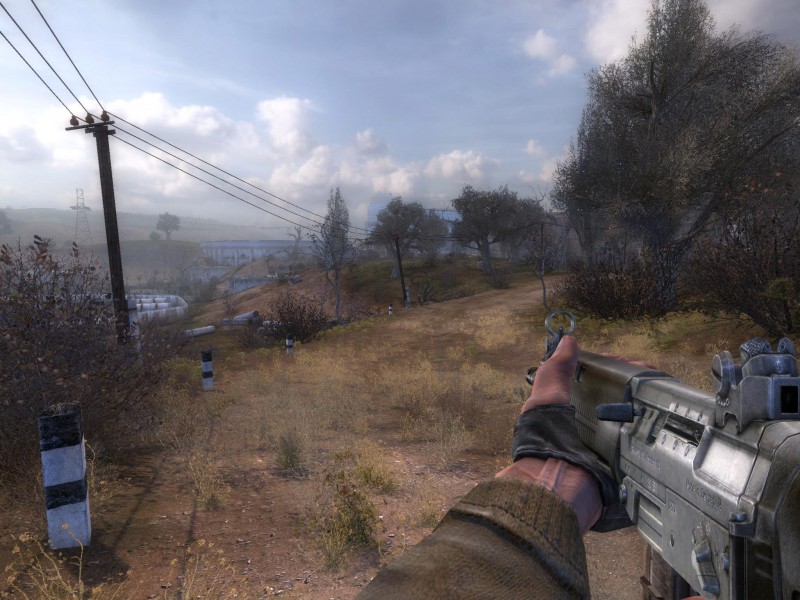Please support Game Informer. Print magazine subscriptions are less than $2 per issue
Tracing The Lineage Of S.T.A.L.K.E.R.: Shadow Of Chernobyl

S.T.A.L.K.E.R. Shadow Of Chernobyl remains, years later, an exquisitely peculiar game. Released in 2007, the RPG/FPS hybrid was praised for its open spaces, interlocking survival systems, and mysterious setting. Awaking inside a 30 km radioactive zone based on the real-life Chernobyl Exclusion Zone, the player takes on the role of a Stalker, a sort of bandit that explores "the Zone" in search of artifacts that catch a hefty market price.
The game’s hyper-focus on survival, which had you managing hunger, radioactivity levels, and injuries years before the likes of The Long Dark and Don’t Starve, as well as its ambiguous morality system, leading to branching endings, has kept the attention of a devoted audience – with mods continuing to emerge more than a decade later.
In a way, S.T.A.L.K.E.R. was always destined to be an oddball game, if it was ever going to be a worthwhile adaptation of its source material (good news: it is!). Even in the strange world of video game adaptations, where things like the Battle Chasers comic-book series transforming into a video game are the norm, S.T.A.L.K.E.R’s origins are unique and (fittingly) murky.

STALKER – The Book
The foundation of what would ultimately become S.T.A.L.K.E.R. was born in 1971 as Roadside Picnic, a sci-fi novel written by the brothers Arkady and Boris Strugatsky. A Russian novel written during The Cold War, the book was hard sci-fi, thematically taking on the concept of dystopia, man’s inhumanity to man, as well as mankind’s inability to accept the mysteries of life for what they are: mysteries.
The book introduces a version of the world that would eventually germinate into S.T.A.L.K.E.R decades later, with Redrick “Red” as a Stalker attempting to cure his daughter’s radioactive mutation by sneaking into The Zone one last time to find a Golden Sphere, which supposedly has the ability to grant whoever is before it one wish.
The Zone itself is a consequence of what one character uses a "roadside picnic" as an analogy to explain, with extraterrestrials visiting Earth and discarding their "trash" before leaving again. The trash is, of course, mysterious to humanity and the energy within it helps develop technological evolutions while also having a negative effect on the environment and people within The Zone (likely a thematic reference to the 1957 nuclear disaster in Kyshtym, in which a nuclear processing plant exploded and covered the surrounding area in radiation).
The novel isn’t caught up in the ambiguity of later iterations of the story. Its characters are defined, with desires and flaws, and Harmont, the Canadian town outside of The Zone, is given more time than The Zone itself. There’s a lot of philosophical conversation between scientists about the meaning of life and how people are cruel to each other.
In the end, Roadside Picnic’s version of The Zone feels more like a tool for thematic delivery rather than an exploration of interesting setting, with the novel focusing more on the interactions of its characters and the society that’s been built outside of (and because of) The Zone.
In 1979, film director Andrei Tarkovsky would change that, throwing the outside world to the side in order to focus on the horrors and wonder of The Zone.

STALKER – The Movie
Stalker is a sci-fi movie that barely bothers with the sci-fi, and it’s that much stronger for that reason. Taking the Strugatsky’s brothers’ concept of The Zone and Stalker, and essentially throwing everything else away, Tarkovsky also moved the setting to Russia. Stalker focuses on an unnamed Stalker as he guides two other men, a scientist named Professor and an author named Writer through The Zone in search of a room that’s said to grant the wishes of whoever steps inside.
We do get a brief glimpse into the world outside of The Zone, which is presented in an eerie monochrome color suggesting that the protagonist’s notions of home, space, and time have been distorted by his frequent trips to the The Zone. Tarkovsky ditches the gruff, antihero Stalker that Red was, instead changing his hero into a holy fool of sorts, a man who knows the dangers of The Zone, carrying metal nuts to test centers where gravity is distorted, but is also prone to babbling pitifully about the horrors of the world.
Often referred to as a “landscape movie,” Stalker is a visually astonishing film obsessed with beauty of nature and decay, aware that they are connected biologically and spiritually. There are no monsters that roam Tarkovsky’s version of The Zone. Man is, to him, an awful and complex enough monster on his own. Instead, during their journey (which takes a 165-minute runtime) our trio faces off against one another and themselves, arguing about Stalker’s seemingly insane rituals to protect them in The Zone as well as the foolishness of the desires that made them seek out The Room in the first place. Stalker is indeed a horror film, but its horrors emerge psychologically, in how it toys with the minds of its victims, as our protagonist explains:
Stalker: The Zone is a very complicated system of traps, and they're all deadly. I don't know what's going on here in the absence of people, but the moment someone shows up, everything comes into motion. Old traps disappear and new ones emerge. Safe spots become impassable. Now your path is easy, now it's hopelessly involved. That's The Zone. It may even seem capricious. But it is what we've made it with our condition. It happened that people had to stop halfway and go back. Some of them even died on the very threshold of the room. But everything that's going on here depends not on The Zone, but on us!
Writer: So it lets the good ones pass and kills the bad ones?
Stalker: I don't know. I think it lets those pass who have lost all hope. Not good or bad, but wretched people. But even the most wretched will die if they don't know how to behave. You have been lucky, it just warned you.
By the end of the film, only two things are certain: None of the people who made the trip are happy or fulfilled, and The Zone continues to produce questions that are unanswerable by any human mind. It’s a cousin of Lovecraftian terror, where you know something is out there, but you don’t know what. The thing about Lovecraft though is that there was always some kind of monster behind the forces he created, something that took shape, it was just wrapped up in layer after layer of mystery. The Zone is just The Zone. It exists independent of humans. And its victims can’t tell if it bears them ill will or The Zone automatically bends time and space by just existing. There’s a level of indifference there that makes things much more awful and cold – horror that is simply the natural order of things.
It’s this brand of horror that developer GSC wisely built on to create the most popular version of the Stalker name: A creepy, hardcore first-person shooter that made trespassing into the unknown its crux.

STALKER – The Game
“Does not hold your hand” has become a go-to phrase for describing games that are difficult and make the player fend for themselves. S.T.A.L.K.E.R. most certainly fits this mold, forcing you to explore The Zone at your own peril and discover what you need to do to survive and progress the story.
S.T.A.L.K.E.R. does an incredible job of making its world immersive. The Zone feels like a place that exists separate from you, that if you were taken out of the equation, it would continue operating as is, with radioactive mutants and bandits fighting one another. It is a place that is ultimately indifferent to you and in that way it captures the true spirit of The Zone that shines through both Tarkovsky and Strugatsky’s visions – the unknowable terror of the world you inhabit. The fact that S.T.A.L.K.E.R. is a game where you’re inhabiting that space also makes that feeling more visceral, as well as the intricate survival systems.
What’s scarier than slowly creeping through an expanse of rotted grass, broken vehicles prowled by all sorts of monsters and highwaymen looking to kill you? Doing it while feeding yourself and monitoring how deeply soaked your body is in radioactivity is a pretty compelling addition. Oh, and let’s not forget the strange anomalies that haunt The Zone, such as flying orbs of fire and ruptures in gravity that damage you if you get too close.
S.T.A.L.K.E.R. Shadow Of Chernobyl stakes its identity in the world it builds and, despite the countless post-apocalyptic games it finds itself facing, manages to succeed. The Zone is a terrifying place, and it’s fascinating to watch how it takes shape across three different mediums from three different creators. The reason that S.T.A.L.K.E.R. shines is because the high point of every single incarnation of Stalker is environmental, and (in the right hands) games excel at wringing fantastical, immersive environments for all their worth. In that regard, The Zone, with all of its sorrowful enigmas, stands among the best settings in video games, creating a captivating world while also doing justice by its rich, established history.










